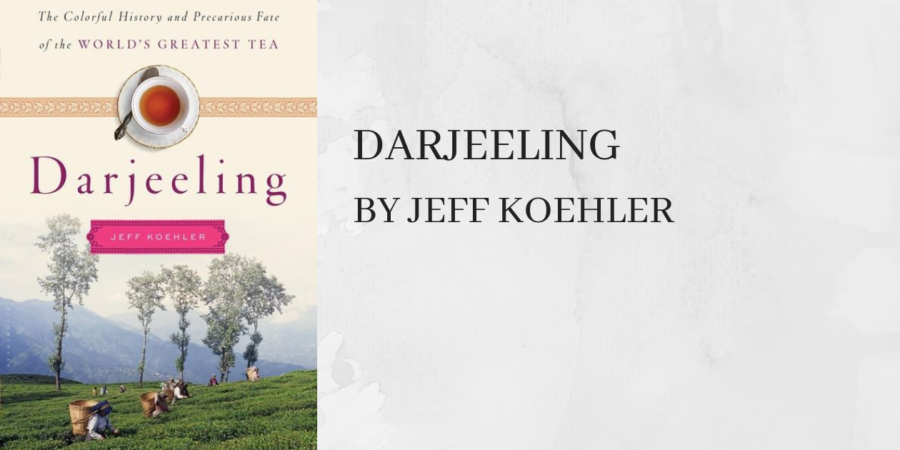Since I spent last year doing quite a bit of general reading about tea, I thought I’d take it a bit more in-depth this year. That means taking both a wider look at the issues surrounding tea (hopefully there’s a contemporary book or blog I can read!) and going in depth into the history of teas. Darjeeling focuses on one specific tea, so it’s exactly what I’m looking for.
Subtitled “The Colorful History and Precarious Fate of the World’s Greatest Tea” (I suspect many in China might dispute the title), the book is divided into 4 sections, for the four flushes. Each section starts with a description of the tea made from that flush, and then goes into either the history or present of the tea. The first flush starts with a general history of tea and then moves into a history of the region. The second flush goes into detail about Darjeeling, how the area was developed and how the tea is made today. The third flush, Monsoon Flush, looks at the history of the area and how that has impacted the plantations, as well as the crises faced by the farms today. Finally, the fourth flush, the Autumn Flush, covers the modern Darjeeling industry, including the question of organic and biodynamic farming, tourism, and even co-op farms. The book ends with a collection of recipes, and I have to admit I only glaced through that.
This book was fascinating and I learnt a lot from it. As it turns out, Darjeeling was first grown by Dr. Archibald Campbell, a Scottish civil servant, in 1841 “with stock that came from the nurseries in the western Himalayan foothills. The trees came to bear in the second half of that decade, and the Company inspector reported in 1853 that both Chinese and Assam varieties were doing well in Campbell’s garden.” The tea was actually a happy accident, as the British discovered that the Chinese plants smuggled over thrived in the mountainous climate of Darjeeling.
And it is this climate that affects the taste – that’s why Darjeeling was awarded Geographical Indication status by the WTO in 2004, and Protected Geographical Indication (PGI) by the European Commission in October 2011. According to the book, the combination of sunshine for no more than 5-6 hours a day for 180 days, mists and clouds as well as enough water and just enough sun gives it is unique flavour, while proximity to the snow-covered Himalayas “gives a ‘crisping effect’ to flavour”. Plus, the “human touch in every step” makes it unique.
I mentioned four flushes just now. They are:
- First flush (late Feb to Mid April): This is a spring tea, and the steeped liquour is pale gold, with grassy and floral notes.
- Second flush (May to June): This tea is fuller but still relaxed, less grassy flavours, muscatel flavour more pronounced. Its colour is a “bright, deep amber”.
- Moonsoon flush (July to September): The tea tea becomes even redder, while the heavy rain causes the prices to drop. This season’s teas are mostly sold as blends. There are also some green teas made from this flush, although other estates do set aside teas from ‘better’ flushes to make green tea as well.
- Autumn Flush (October into November): the tea liquor “ruddy copper, bright auburn, even burgundy” while the flavour is more robust and round with “mellowed hints of musky spice and smoke”. The tea from this flush is considered to have the most complex flavours, while its prices are not as high as the first and second flushes, thanks to the outside world being busy with Christmas.
I also learnt that there are other, non-black, Darjeeling teas: Apart from the green teas made during the monsoon season, there are also white teas (e.g. Silver Tips Imperial from Makaibari), and oolong.
Sadly, Darjeeling tea faces challenges such as
- Climate change, which results in the rain comes at the wrong time and reducing the harvest;
- High worker absenteeism, which in some gardens go as high as 50% while others are 25-30%. A large factor for this is the fact that tea plucking isn’t seen as a desirable job, even by families who have always been tea pluckers;
- Severe political instability because West Bengal would like to be independent and bandh – shutdowns- are not uncommon. This also impacts Darjeeling teas.
- Counterfeiting from teas grown outside of Darjeeling. This is somewhat countered by Darjeeling’s PGI status, but farms grown from regions near Darjeeling are becoming competitive. Plus, the shutdowns make alternatives to Darjeeling appealing to buyers who want a steady supply of tea that tastes like Darjeeling.
I would recommend this book to anyone who’s looking into studying more about Darjeeling tea. This book goes beyond the taste and history of Darjeeling, covering the challenges it faces and the initiatives it’s undertaking as well. There are also lots of stories about the tea gardens of Darjeeling, which are sure to appeal to any tea lover.
